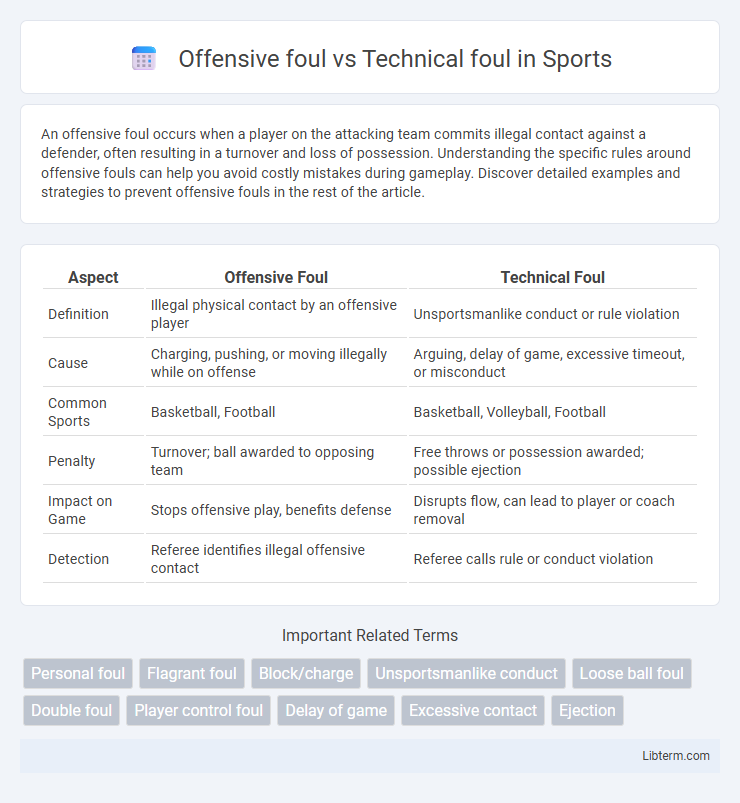An offensive foul occurs when a player on the attacking team commits illegal contact against a defender, often resulting in a turnover and loss of possession. Understanding the specific rules around offensive fouls can help you avoid costly mistakes during gameplay. Discover detailed examples and strategies to prevent offensive fouls in the rest of the article.
Table of Comparison
| Aspect | Offensive Foul | Technical Foul |
|---|---|---|
| Definition | Illegal physical contact by an offensive player | Unsportsmanlike conduct or rule violation |
| Cause | Charging, pushing, or moving illegally while on offense | Arguing, delay of game, excessive timeout, or misconduct |
| Common Sports | Basketball, Football | Basketball, Volleyball, Football |
| Penalty | Turnover; ball awarded to opposing team | Free throws or possession awarded; possible ejection |
| Impact on Game | Stops offensive play, benefits defense | Disrupts flow, can lead to player or coach removal |
| Detection | Referee identifies illegal offensive contact | Referee calls rule or conduct violation |
Understanding Basketball Fouls: An Overview
Offensive fouls occur when a player with the ball commits illegal physical contact, such as charging or pushing, disrupting the defensive player's position. Technical fouls involve unsportsmanlike conduct, violations by players or coaches that do not involve physical contact during play, including arguing with referees or delaying the game. Understanding these distinctions helps clarify foul consequences and impacts game strategy in basketball.
Definition of Offensive Foul
An offensive foul occurs when a player with the ball commits illegal physical contact against a defender, such as charging or pushing, disrupting defensive positioning. It results in a turnover with the defending team gaining possession. A technical foul, in contrast, relates to unsportsmanlike behavior or violations not involving physical contact during play.
Definition of Technical Foul
A technical foul is a violation of sportsmanship rules, often related to player or coach misconduct, such as arguing with referees, unsportsmanlike behavior, or delay of game, and it results in free throws or possession changes depending on the sport. Unlike an offensive foul, which involves illegal physical contact committed by a player with the ball during an offensive play, a technical foul addresses non-contact infractions that disrupt the game's flow or fairness. Understanding the distinction is crucial for players and officials to maintain discipline and enforce correct penalties in basketball or other team sports.
Key Differences Between Offensive and Technical Fouls
Offensive fouls occur when an offensive player commits illegal physical contact, such as charging into a defender, resulting in a turnover and awarding the ball to the opposing team. Technical fouls, on the other hand, are penalties for unsportsmanlike conduct, rule violations by players or coaches, or delay of game, often resulting in free throws for the opposing team without possession change. The primary difference lies in offensive fouls relating to physical play during scoring attempts, while technical fouls address behavioral infractions and administrative violations.
Common Examples of Offensive Fouls
Common examples of offensive fouls include charging, where an attacker illegally collides with a defender who has established position, and illegal screens, which occur when a player setting a pick moves or blocks improperly. Other offensive fouls may involve pushing off defenders with the arm or initiating contact that is deemed excessive or unfair by officials. These fouls typically result in turnovers and can shift momentum, as players lose possession and the opposing team gains control of the ball.
Common Examples of Technical Fouls
Common examples of technical fouls in basketball include unsportsmanlike conduct such as arguing with referees, taunting opponents, or excessive timeouts. Players and coaches may also receive technical fouls for delay of game or hanging on the rim unnecessarily. Unlike offensive fouls, which involve illegal physical contact during play, technical fouls address violations of sportsmanship and procedural rules.
Impact of Offensive Fouls on Gameplay
Offensive fouls disrupt offensive momentum by causing turnovers and halting fast breaks, significantly impacting a team's scoring opportunities. They impose possession changes and often negate scoring plays, forcing teams to reset their offensive strategies. The frequency of offensive fouls can alter game tempo, enabling defensive teams to capitalize on increased control and shift the game's flow.
Consequences of Technical Fouls in Basketball
Technical fouls in basketball result in an immediate free throw for the opposing team and possession of the ball, significantly impacting game momentum. Unlike offensive fouls, which usually lead to a change of possession without free throws, technical fouls penalize unsportsmanlike conduct, delay of game, or infractions by coaches and players. Accumulating multiple technical fouls can lead to player ejection, affecting team dynamics and strategies.
How Referees Determine Offensive vs. Technical Fouls
Referees determine offensive fouls by observing illegal personal contact initiated by the ball-handler, such as pushing, charging, or using the body to gain an unfair advantage during play. Technical fouls are assessed based on unsportsmanlike conduct, including inappropriate language, delayed game actions, or violations by non-players like coaches and bench personnel. The key differentiation lies in the nature of the infraction: offensive fouls involve physical contact related to ball control, whereas technical fouls address behavioral or procedural violations unrelated to direct gameplay.
Preventing Fouls: Tips for Players and Coaches
Offensive fouls require players to maintain control and avoid illegal physical contact such as charging, emphasizing footwork and spatial awareness during offensive moves. Coaches should train athletes to anticipate defensive positioning and use proper techniques like pivoting to minimize offensive fouls. Technical fouls arise from unsportsmanlike conduct or rule infractions unrelated to physical play, so promoting discipline, communication, and emotional control is essential for preventing these violations.
Offensive foul Infographic

 libterm.com
libterm.com